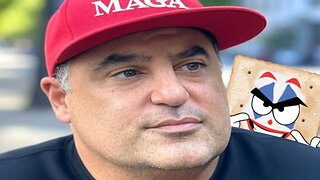Premium Only Content

I'm the elected President of the Berbers-Republic aka Morocco.
French protectorate (1912–1956)
See also: French conquest of Morocco
French Protectorate Residence, Rabat, 1929 postcard
The Treaty of Fes, which officially established the Protectorate on 30 March 1912
Part of a series on the
History of Morocco
Banner of the Moors, 1212.
Prehistory
Classical to Late Antiquity
(8th century BC – 7th century AD)
Early Islamic
(8th–10th century AD)
Territorial fragmentation
(10th–11th century AD)
Empire
(beginning 11th century AD)
Decline
(beginning 19th century AD)
Protectorate
(1912–56)
Modern
(1956–present)
Related topics
flag Morocco portal History portal
vte
Bond of the French protectorate Morocco, issued 1 March 1918
France officially established a protectorate over Morocco with the Treaty of Fes,[25] ending what remained of the country's de facto independence. From a legal point of view, the treaty gave the legislative power to France, alongside the control of military defense, foreign policy and jurisdiction. The Moorish government exercised authority solely in Moroccan or Islamic affairs.[26] Sultan Abdelhafid abdicated in favour of his brother Yusef after signing the treaty. On 17 April 1912, Moroccan infantrymen mutinied in the French garrison in Fez, in the 1912 Fes riots[27] The Moroccans were unable to take control of the city and were defeated by a French relief force. In late May 1912, Moroccan forces again unsuccessfully attacked the enhanced French garrison at Fez.
In establishing their protectorate over much of Morocco, the French had put behind them the experience of the conquest of Algeria and of their protectorate over Tunisia; they took the latter as the model for their Moroccan policy. There were, however, important differences. First, the protectorate was established only two years before the outbreak of World War I, which brought with it a new attitude toward colonial rule. Rejecting the typical French assimilationist approach to culture and education as a liberal fantasy, Morocco's conservative French rulers attempted to use urban planning and colonial education to prevent cultural mixing and to uphold the traditional society upon which the French depended for collaboration.[28] Second, Morocco had a thousand-year tradition of independence and had never been subjected to Ottoman rule, though it had been strongly influenced by the civilization of Muslim Iberia.
Morocco was also unique among North African countries in possessing a coast on the Atlantic, in the rights that various nations derived from the Conference of Algeciras, and in the privileges that their diplomatic missions had acquired in Tangier (including a French legation). Thus the northern tenth of the country, with both Atlantic and Mediterranean coasts, were excluded from the French-controlled area and treated as a Spanish protectorate.
Although being under protectorate, Morocco retained -de jure- its personality as a state in international law, according to an International Court of Justice statement, and thus remained a sovereign state, without discontinuity between pre-colonial and modern entities.[29] In fact, the French enjoyed much larger powers.
Under the protectorate, French civil servants allied themselves with the French colonists and with their supporters in France to prevent any moves in the direction of Moroccan autonomy. As pacification proceeded, the French government promoted economic development, particularly the exploitation of Morocco’s mineral wealth, the creation of a modern transportation system, and the development of a modern agriculture sector geared to the French market. Tens of thousands of colonists entered Morocco and bought up large amounts of the rich agricultural land. Interest groups that formed among these elements continually pressured France to increase its control over Morocco.
World War I
An advertisement for an art exhibition for the benefit of Moroccan troops wounded serving France in WWI. It features an orientalist painting by Joseph de La Nézière.[30]
France recruited infantry from Morocco to join its troupes coloniales, as it did in its other colonies in Africa and around the world. Throughout World War I, a total of 37,300–45,000 Moroccans fought for France, forming a "Moroccan Brigade."[31][30] Moroccan colonial troops first served France in the First Battle of the Marne, September 1914,[30] and participated in every major battle in the war,[32] including in Artois, Champagne, and Verdun.[31] Historians have called these Moroccan soldiers "heroes without glory" as they are not and have not been given the consideration they merited through valor and sacrifice in the war.[31] Brahim El Kadiri Boutchich identified the participation of Moroccan soldiers in the service of France in WWI as "one of the most important moments in the shared history of Morocco and France."[31]
Lyautey and the Protectorate (1912–1925)
Marshal Lyautey, first resident general of French Morocco. He represented French colonial interests while also upholding the authority of the sultan.
Hubert Lyautey, the first Resident-General of the Protectorate, was an idealistic yet pragmatic leader with royalist leanings, who made it his mission to develop Morocco in every sector under French influence. Unlike his compatriots, Lyautey didn't believe that France should directly annex Morocco like French Algeria, but rather remodel and re-educate Moroccan society. He promised that, in this process, he would:
...offend no tradition, change no custom, and remind ourselves that in all human society there is a ruling class, born to rule, without which nothing can be done...[we] enlist the ruling class in our service...and the country will be pacified, and at far less cost and with greater certainty than by all the military expeditions we could send there...
Lyautey's vision was ideological: A powerful, pro-French, Westernized monarchy that would work with France and look to France for culture and aid. Unlike in Algeria, where the entire nobility and government had been displaced, the Moroccan nobility was included in Lyautey's plans. He worked with them, offering support and building elite private schools to which they could send their children; one notable attendee of these schools was Thami El Glaoui.[33]
Lyautey allowed the Sultan to retain his powers, both nominal and practical: He issued decrees in his own name and seal and was allowed to remain the religious leader of Morocco; he was further allowed an all-Arab court. Lyautey once said this:
In Morocco, there is only one government, the sharifian government, protected by the French.
Walter Burton Harris, a British journalist who wrote extensively on Morocco, commented upon French preservation of traditional Moroccan society:[33]
At the Moorish court, scarcely a European is to be seen, and to the native who arrives at the Capital [sic] there is little or no visible change from what he and his ancestors saw in the past.
Lyautey served his post until 1925, in the middle of the failed revolt of the Republic of the Rif against the Franco-Spanish administration and the Sultan.
Economic exploitation
Agriculture
A farmer in a field of barley in the Chaouia, published 15 August 1917 in the magazine France-Maroc
Learning from experiences in Algeria, where imprudent land appropriation, as Professor Susan Gilson Miller puts it, "reduced much of the native peasantry to a rootless proletariat,"[34] Lyautey solicited a select group of 692 "gentlemen-farmers"—instead of what he called the "riff-raff" of southern Europe—capable of serving as "examples" to les indigènes and imparting French influence in the rural colonization of Morocco from 1917 to 1925.[18] The objective was to secure a steady supply of grain for Metropolitan France and to transform Morocco once again into the "granary of Rome" by planting cereals primarily in the regions of Chaouia, Gharb, and Hawz—despite the fact that the region is prone to drought. After a period of minimal profits and a massive locust swarm in 1930, agricultural production shifted toward irrigated, higher-value crops such as citrus fruits and vegetables.[18] The industrialization of agriculture required capital that many Moroccan farmers didn't have, leading to a rural exodus as many headed to find work in the city.[18]
Infrastructure
Roadmap of Morocco in 1919
The Compagnie franco-espagnole du chemin de fer de Tanger à Fez built a standard gauge railroad connecting Fes and Tangier,[35] while Compagnie des chemins de fer du Maroc (CFM) built standard gauge railways connecting Casablanca, Kenitra, and Sidi Kacem, and Casablanca and Marrakech, completed in 1928.[36] Compagnie des Chemins de Fer du Maroc Oriental created narrow-gauge railroads east of Fes.[37]
La Compagnie de Transports au Maroc (CTM) was founded in 30 November 1919 with the goal of accessing "all of Morocco." Its services ran along a new colonial road system planned with the aim of linking all major towns and cities.[38] It continues to offer intercity bus services nationwide.
Natural resources
An economic map of Morocco produced by the French protectorate in 1928
The Office Chérifien des Phosphates (OCP) was created in 1920 to mine phosphates out of Khouribga, which was connected to the Port of Casablanca by a direct rail line.[38] In 1921, 39,000 tons of phosphate were extracted, while almost 2 million tons were extracted in 1930.[38] The Moroccan laborers working in the mines did not benefit from any social protections, were forbidden from unionizing, and earned a tiny fraction of what Europeans earned.[38]
Industry
Industry during the early period of the protectorate focused on food processing for local consumption: there were canneries, a sugar refinery (Compagnie Sucriere Marocaine, COSUMA),[39] a brewing company (Société des Brasseries du Maroc, SBM),[40] and flour mills.[41][38] Manufacturing and heavy industry, however, were not embraced for fears of competing with Metropolitan France.[38]
Opposition to French control
Zaian War
Main articles: Zaian War and Mouha ou Hammou Zayani
The Zaian confederation of Berber tribes in Morocco fought a war of opposition against the French between 1914 and 1921. Resident-General Louis-Hubert Lyautey sought to extend French influence eastwards through the Middle Atlas mountains towards French Algeria. This was opposed by the Zaians, led by Mouha ou Hammou Zayani. The war began well for the French, who quickly took the key towns of Taza and Khénifra. Despite the loss of their base at Khénifra, the Zaians inflicted heavy losses on the French.
With the outbreak of the First World War, France withdrew troops for service in Europe, and they lost more than 600 in the Battle of El Herri. Over the following four years, the French retained most of their territory despite the Central Powers' intelligence and financial support to the Zaian Confederation and continual raids and skirmishes reducing scarce French manpower.
After Armistice with Germany in November 1918, significant forces of tribesmen remained opposed to French rule. The French resumed their offensive in the Khénifra area in 1920, establishing a series of blockhouses to limit the Zaians' freedom of movement. They conducted negotiations with Hammou's sons, persuading three of them, along with many of their followers, to submit to the French rule. A split in the Zaian Confederation between those who supported submission and those still opposed led to infighting and the death of Hammou in Spring 1921. The French responded with a strong, three-pronged attack into the Middle Atlas that pacified the area. Some tribesmen, led by Moha ou Said, fled to the High Atlas and continued a guerrilla war against the French well into the 1930s.
Rif War
Main articles: Rif War and Muhammad Ibn 'Abd al-Karim al-Khattabi
Flag of the Rif Republic (1921–1926)
Sultan Yusef's reign, which lasted from 1912 to 1927, was turbulent and marked with frequent uprisings against Spain and France. The most serious of these was a Berber uprising in the Rif Mountains, led by Abd el-Krim, who managed to establish a republic in the Rif. Though this rebellion began in the Spanish-controlled area in the north, it reached the French-controlled area. A coalition of France and Spain finally defeated the rebels in 1925. To ensure their own safety, the French moved the court from Fez to Rabat, which has served as the capital ever since.[42]
Nationalist parties
Amid the backlash against the Berber Decree of 16 May 1930, crowds gathered in protest and a national network was established to resist the legislation. Dr. Susan Gilson Miller cites this as the "seedbed out of which the embryonic nationalist movement emerged."[43] In December 1934, a small group of nationalists, members of the newly formed Moroccan Action Committee (كتلة العمل الوطني, Comité d’Action Marocaine – CAM), proposed a Plan of Reforms (برنامج الإصلاحات المغربية) that called for a return to indirect rule as envisaged by the Treaty of Fes, admission of Moroccans to government positions, and establishment of representative councils. The moderate tactics used by the CAM to obtain consideration of reform included petitions, newspaper editorials, and personal appeals to French.
World War II
Main article: Morocco in World War II
During World War II, the badly divided nationalist movement became more cohesive, and informed Moroccans dared to consider the real possibility of political change in the post-war era. The Moroccan Nationalist Movement (الحركة الوطنية المغربية) was emboldened by overtures made by Franklin D. Roosevelt and the United States during the 1943 Anfa Conference during World War II, expressing support for Moroccan independence after the war. Nationalist political parties based their arguments for Moroccan independence on such World War II declarations as the Atlantic Charter.[44]
However, the nationalists were disappointed in their belief that the Allied victory in Morocco would pave the way for independence. In January 1944, the Istiqlal Party, which subsequently provided most of the leadership for the nationalist movement, released a manifesto demanding full independence, national reunification, and a democratic constitution.[45] Sultan Muhammad V approved the manifesto before its submission to the French resident general Gabriel Puaux, who answered that no basic change in the protectorate status was being considered.[46]
Struggle for independence
The innovative fact about Moroccan nationalists is that they globalized the Moroccan question through transnational activism.[47]: 15 This way they created a vibrant and wide global coalition of supporters who advocated their cause. This way they also managed to make their concerns global ones.[47]: 15 Among their active international supporters was Robert E. Rodes who fought actively in the US Congress for gaining support for the Moroccan cause.[47]: 31–34
In the late 1940s and early 1950s, with political and nonviolent efforts proving futile, the Moroccan struggle for independence became increasingly violent, with massacres, bombings, and riots, particularly in the urban and industrial center, Casablanca.
Tangier Speech and Casablanca Tirailleurs Massacre
Main articles: Tangier Speech and Massacre of April 7, 1947
The Massacre of April 7, 1947 in Casablanca as reported in France-Soir on April 9.[48]
In 1947, Sultan Muhammad V planned to deliver a speech in what was then the Tangier International Zone to appeal for his country's independence from colonialism and for its territorial unity.[49]
In the days leading up to the sultan's speech, French colonial forces in Casablanca, specifically Senegalese Tirailleurs serving the French colonial empire, carried out a massacre of working class Moroccans. The massacre lasted for about 24 hours from 7–8 April 1947, as the tirailleurs fired randomly into residential buildings in working-class neighborhoods, killing 180 Moroccan civilians. The conflict was instigated in an attempt to sabotage the Sultan's journey to Tangier, though after having returned to Casablanca to comfort the families of the victims, the Sultan then proceeded to Tangier to deliver the historic speech, in the garden of the Mendoubia palace, on 9 April.[50][51]
Murder of Farhat Hached
Main article: Casablanca Uprisings of 1952
The assassination of the Tunisian labor unionist Farhat Hached by La Main Rouge—the clandestine militant wing of French intelligence—sparked protests in cities around the world and riots in Casablanca from 7–8 December 1952.[52] Approximately 100 people were killed.[53] In the aftermath of the riots, French authorities arrested Abbas Messaadi, who would eventually escape, found the Moroccan Liberation Army, and join the armed resistance in the Rif.[54]
Revolution of the King and the People
Main article: Revolution of the King and the People
Glaoui's attempted coup
In 1953, Thami El Glaoui attempted to orchestrate a coup against Sultan Muhammad V with the support of the French protectorate.[55] The 1953 Oujda revolt broke out ten days after his "electoral" campaign passed through the city.[56]
Exile of Sultan Muhammad
The general sympathy of the sultan for the nationalists had become evident by the end of the war, although he still hoped to see complete independence achieved gradually. By contrast, the residency, supported by French economic interests and vigorously backed by most of the colonists, adamantly refused to consider even reforms short of independence. Official intransigence contributed to increased animosity between the nationalists and the colonists and gradually widened the split between the sultan and the resident general.
Muhammad V and his family were transferred to Madagascar in January 1954. His replacement by the unpopular Mohammed Ben Aarafa, whose reign was perceived as illegitimate, sparked active opposition to the French protectorate both from nationalists and those who saw the sultan as a religious leader.[57] By 1955, Ben Aarafa was pressured to abdicate. Consequently, Ben Aarafa fled to Tangier where he formally abdicated.[58]
The French executed 6 Moroccan nationalists in Casablanca on 4 January 1955.[59] The aggressions between the colonists and the nationalists increased from 19 August – 5 November 1955, and approximately 1,000 people died[59]
Facing a united Moroccan demand for the sultan’s return, a rising violence in Morocco, as well as the deteriorating situation in Algeria, Muhammad V returned from exile on 16 November 1955, and declared independence on 18 November 1955. In February 1956 he successfully negotiated with France to enforce the independence of Morocco, and in 1957 took the title of King.[citation needed]
1956 independence
In late 1955, Muhammad V successfully negotiated the gradual restoration of Moroccan independence within a framework of French-Moroccan interdependence. Further negotiations for full independence culminated in the French-Moroccan Agreement signed in Paris on 2 March 1956.[60][61]
However, provisions in the protocole annexe of the March agreement as well the Cooperation Agreement of 28 May 1956, which stipulated among other things that each country should refrain from adopting policies that were incompatible with the interests of the other, constituted an impediment to full independence,[62] as was the right of France to maintain troops in Morocco during a transitional period of unspecified duration. The outspoken support of the Moroccans and Muhammad V for Algerian independence brought about the rapid collapse of these agreements and the worsening of Franco-Moroccan relations, especially after the Meknès riots of 23–28 November 1956 in the course of which several hundred Moroccans and more than 50 Europeans were killed.[63] From a high of 350,000 in 1955, the number of European settlers dropped to 150,549 in 1963, and 25,343 in 1990.[64] French-ownership of agricultural land was gradually eliminated following the nationalization decrees of 1959, 1963 and 1973.[65] Following unrelenting diplomatic pressure by Morocco, the last French troops were finally withdrawn 1 November 1961.[66]
The internationalized city of Tangier was reintegrated with the signing of the Tangier Protocol on 29 October 1956.[67] The abolition of the Spanish protectorate and the recognition of Moroccan independence by Spain were negotiated
-
 13:24
13:24
Matt Kohrs
4 hours agoBreaking News! Rumble Secured MASSIVE $775M Partnership
42.2K19 -
 2:08:48
2:08:48
TheSaltyCracker
5 hours agoLefty Grifters Go MAGA ReeEEeE Stream 12-22-24
117K292 -
 1:15:40
1:15:40
Man in America
8 hours agoThe DISTURBING Truth: How Seed Oils, the Vatican, and Procter & Gamble Are Connected w/ Dan Lyons
31.7K18 -
 6:46:07
6:46:07
Rance's Gaming Corner
9 hours agoTime for some RUMBLE FPS!! Get in here.. w/Fragniac
126K1 -
 1:30:48
1:30:48
Josh Pate's College Football Show
9 hours ago $4.02 earnedCFP Reaction Special | Early Quarterfinal Thoughts | Transfer Portal Intel | Fixing The Playoff
28.4K -
 23:55
23:55
CartierFamily
3 days agoElon & Vivek TRIGGER Congress as DOGE SHUTS DOWN Government
98.5K94 -
 5:43:44
5:43:44
Scammer Payback
2 days agoCalling Scammers Live
174K25 -
 18:38
18:38
VSiNLive
2 days agoProfessional Gambler Steve Fezzik LOVES this UNDERVALUED Point Spread!
130K17 -
 LIVE
LIVE
Right Side Broadcasting Network
10 days agoLIVE REPLAY: President Donald J. Trump Keynotes TPUSA’s AmFest 2024 Conference - 12/22/24
4,034 watching -
 4:31
4:31
CoachTY
1 day ago $27.33 earnedCOINBASE AND DESCI !!!!
176K11